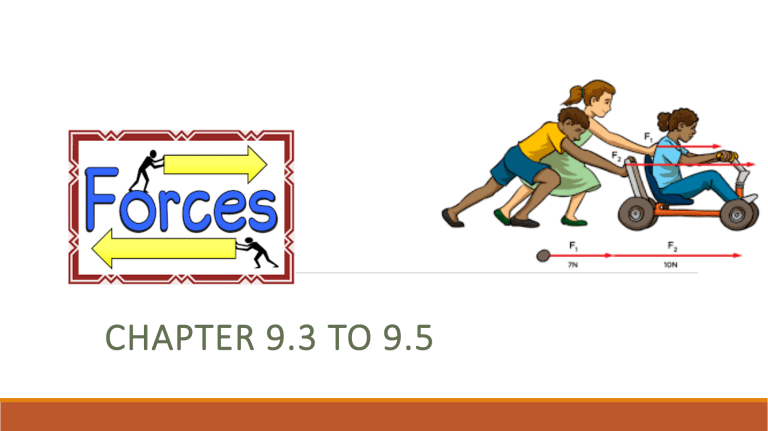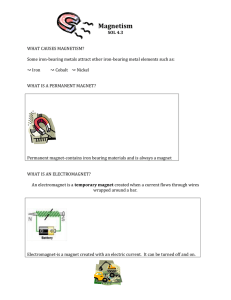
FORCES CHAPTER 9.3 TO 9.5 8.3 Forces can be contact or non-contact Contact- 2 objects touch Non – contact- objects exert force without touching ie. Magnets/ gravity Magnets- alloy (mixture of metals) mostly iron. Most schools use an alloy alnico (iron mixed with aluminium, nickel and cobalt). The magnet is said to have two magnetic poles – north and south. One end is labelled ‘N’ for north and the other ‘S’ for south. The two unlike poles (a north and a south) attract each other. The north and south pole of each magnet are pulled to each other→ attraction force. Non -like attracts/ Like repels Two like poles (ie two north poles or two south poles) push each other apart. They repel each other therefore this is called a repulsion force. Make your own magnet An iron needle can be made to become a magnet by sliding a strong magnet along one side of it (in one direction only). The strong magnet pulls tiny groups of particles so that they all line up in one direction. Each time you stroke the needle, these particles line up. This causes larger sections of the magnet called domains to point in the same direction. When most of the domains are pointing the same way, they can pull or attract a metal pin. Dropping the needle can cause the domains to become mixed up again. 8.4 Magnetic Field Magnetic Field - area where the magnetic force acts Each of the tiny iron filings in the photograph above is attracted to the magnet. The filings line up in the direction of the magnetic force around the magnet. The magnetic field can be drawn like a map, as in the diagram below. The lines show the direction of the magnetic force. The lines are closest together where the magnetic force is greatest and furthest apart where the magnetic field is weakest. Magnetic fields A compass or iron filings could be used to map the field around a bar magnet. The lines of magnetic field appear to directly connect the magnets when there is attraction. The lines of the magnetic field coming from each magnet appear to deflect to either side. The Earth’s magnetic field When a bar magnet is suspended by a string at its centre, it always lines up with the North and South Poles of the Earth. The Earth, like the sun and some planets, has its own magnetic field, very much like the magnetic field of a bar magnet. The Earth's magnetic poles are actually pretty far from its geographic poles. The magnetic field is changing and even flips over! 8.5 Electrostatic Forces Electrostatic Forces 1. Rub balloon on to your hair 2. Then pull the balloon away from head and observe what happens 3. Hold balloon on to the wall (ensure side rubbed on head is facing wall) 4. What do you observe? 5. Try the side that was not rubbed on your head- is there a difference? 6. Try holding 2 charged balloons close together as well as one charged and one uncharged balloon close together 7. Hold a charged balloon near a feather/ salt/ pepper/table tennis ball/ pieces of torn paper/ a steady stream of water and record observations Two objects rub against each other building up a small electrical charge One object becomes positively (+) charged and the other becomes negatively (–) charged. These two charges act like the north and south poles of a magnet- unlike will attract. Hair becomes positive, balloon becomes negative Balloon will attract positive hair making it stand on end Balloon will repel electrons in the neutral wall Electrostatic charges are non-contact forces. Electrostatic forces are created when electrical charges (either positive or negative) come close to each other or close to uncharged objects. The negatively charged balloon pushes electrons away from the stream of water nearest the balloon, leaving this area slightly positive. This positively charged water is attracted to the balloon so the stream is deflected. Some objects readily give up electrons and others readily gain electrons. Human hands readily give up electrons (when not moist)


